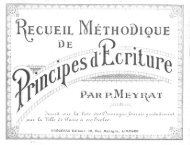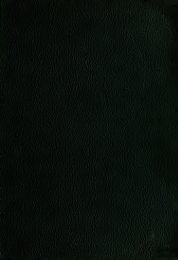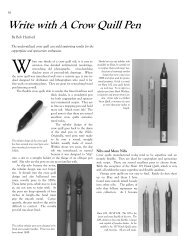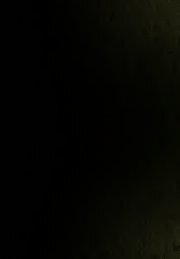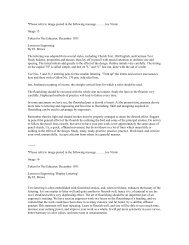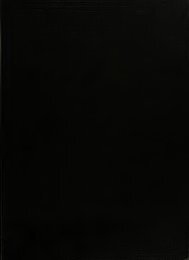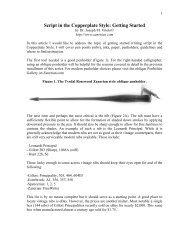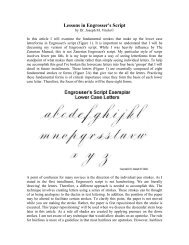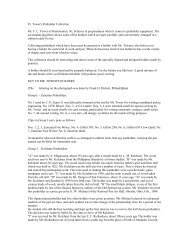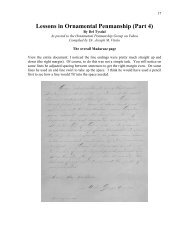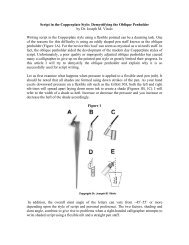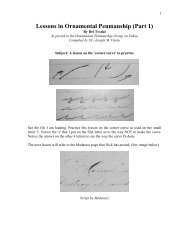The Educator (Volume 45) - IAMPETH
The Educator (Volume 45) - IAMPETH
The Educator (Volume 45) - IAMPETH
You also want an ePaper? Increase the reach of your titles
YUMPU automatically turns print PDFs into web optimized ePapers that Google loves.
16<br />
A Modern Working Plan of<br />
This shows the proper position for<br />
right-handed student at the blackboard.<br />
One should stand erect and<br />
well back from the board.<br />
First grade writing on paper<br />
or manuscript.<br />
paper should be fairly large—about<br />
one-fourth inch for minimum letters<br />
and three-fourths of an inch for capitals<br />
and extended loop letters. If all<br />
writing is of a fair size, if careful<br />
attention is given to hygienic posture,<br />
and if pencil holding is reasonably<br />
good, the pupils will write with some<br />
ease and freedom. See that the<br />
lai'ger muscles of the arm woi'k in<br />
should be large<br />
^^^.^-^-^^^^^7^^y<br />
Instruction in Handwriting<br />
A Guide For Teachers<br />
By C. E. DONER<br />
Grades 1-2. Create in the mind of<br />
the pupil a desire to learn to write<br />
well. <strong>The</strong> interest of the pupil is<br />
caught and held by the story, by music,<br />
and by rhymes and jingles. Stress<br />
form in words, simple sentences, and<br />
pupil's name, first at the board, then<br />
on paper. <strong>The</strong> following list of words<br />
will give practice in all the small<br />
letters:—one, can, did, ice, for, dog,<br />
be, have, dime, joy, kite, ball, me,<br />
run, do, pie, quiet, i-ain, yes, the, up,<br />
vine, now, six, joy, you, zoo, fly, fish,<br />
kind. In teaching individual letters<br />
present them in "family groups" such<br />
as, a d g q, n m V X y, O D A C E,<br />
\ M H K, etc. <strong>The</strong> size of writing<br />
on the board should be about two<br />
inches for minimum letters and four<br />
inches for capitals and extended loop<br />
letters. Children should use a half<br />
piece of chalk, stand back from the<br />
board, and do the ei'asing with the<br />
left hand. Begin the training in right<br />
habits of posture, placing the arms<br />
and paper in proper position, adjusting<br />
and holding the pencil properly<br />
in the hand. <strong>The</strong> size of writing on<br />
conjunction with the smaller finger<br />
movements. A combination of the<br />
arm and correct finger movement is<br />
the natural way for young and old to<br />
write. Give a few drills in the form<br />
of nursery rhymes for muscular development<br />
and control. Do not insist<br />
upon the application of the socalled<br />
arm movement. Insist upon<br />
good posture, pencil holding, and<br />
Left-handed students should write<br />
with the left hand at the board and<br />
use the eraser with the right hand.<br />
This leaves the left hand free to do<br />
the writing. This is just the opposite<br />
of right-handed students.<br />
plain, neat writing. <strong>The</strong>re should be<br />
no assigned "busy-work" writing in<br />
the primary grades. All written work<br />
should be carefully supervised. Care<br />
must be taken to place correct copies<br />
before the pupils, especially upon the<br />
blackboard. Provide a well-written<br />
name card for each pupil, pasting it<br />
on a iiiece of cardboard to preserve<br />
the edges of the paper.<br />
In the third grade ink is usually introduced. At that time a substantial reduction is made in the size of the writing.<br />
<strong>The</strong> above is a style used in many schools in the third grade.<br />
<strong>The</strong> fourth grade writing should be a little smaller and more like adult writing.



